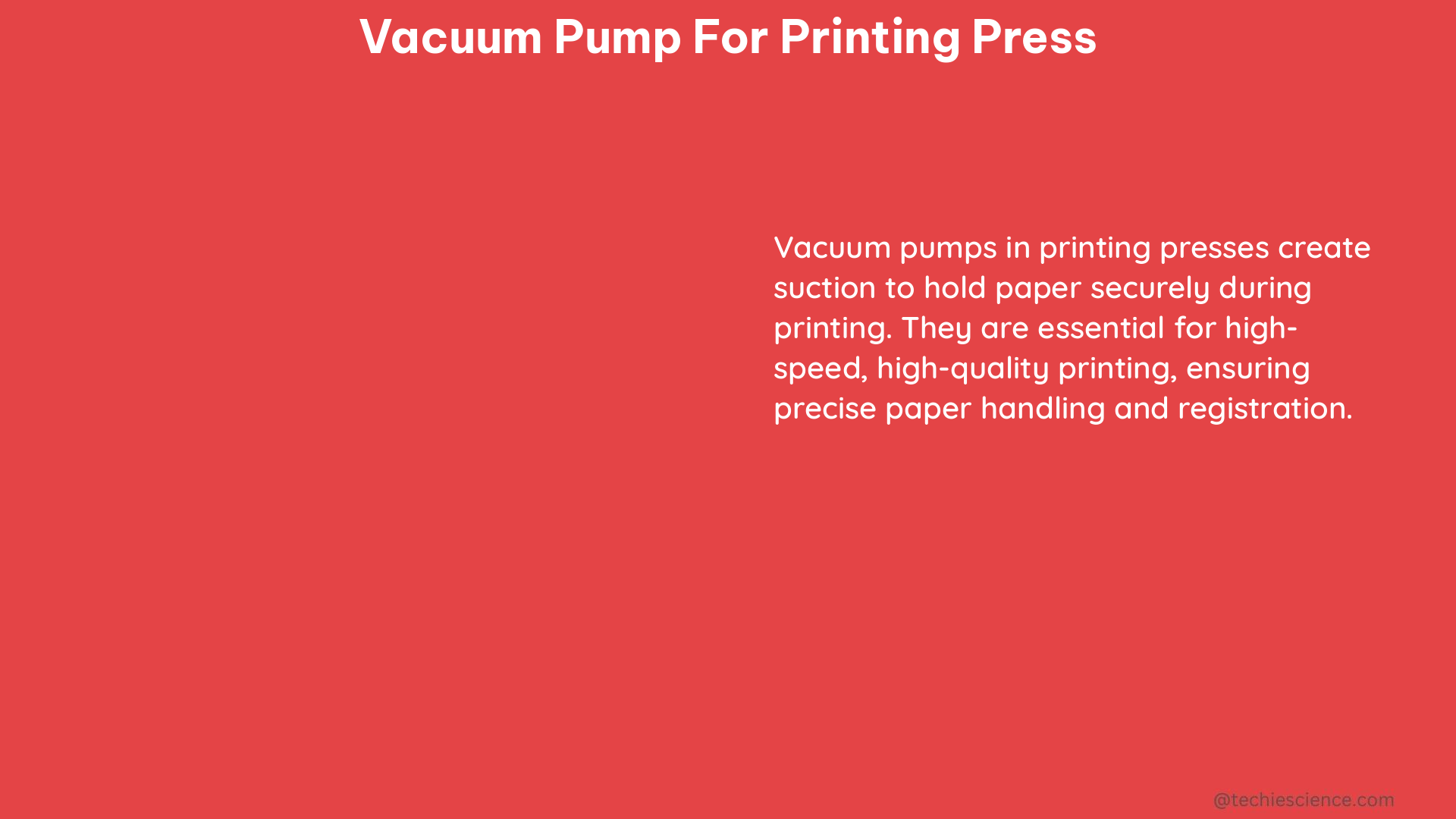Vacuum pumps are an essential component of modern printing presses, particularly in sheet-fed offset printing, where they play a crucial role in paper feeding, separation, and transportation. The choice of vacuum pump for a printing press depends on the specific requirements of the printing process, with dry screw vacuum pumps and oil rotary vane pumps being the most commonly used options. These advanced vacuum pumps offer a range of benefits, including reduced material consumption, easier maintenance, and significant energy savings, making them well-suited for high-speed, automatic paper handling in printing applications.
Understanding the Technical Specifications of Vacuum Pumps for Printing Presses
-
Vacuum Level: The vacuum level required for printing applications can vary, but it typically ranges from 25 inches of mercury (in.-Hg) to 29.92 in.-Hg, corresponding to vacuum levels of -83.4 kilopascals (kPa) to -101.3 kPa, respectively. This high vacuum level is essential for effectively separating, aligning, and transporting paper sheets through the printing process.
-
Pump Capacity: The pump capacity required for printing applications depends on the specific process and the amount of air that needs to be supplied at different pressures. For example, in paper feeding equipment, different amounts of air may be required to separate, align, and distribute paper sheets. Typical pump capacities for printing presses range from 100 cubic feet per minute (CFM) to 500 CFM, with larger presses requiring higher pump capacities.
-
Operating Pressure: The operating pressure of vacuum pumps used in printing applications can range from atmospheric pressure (14.7 psia or 101.3 kPa) to the required vacuum level, which can be as low as 25 in.-Hg or -83.4 kPa. This wide operating pressure range allows the vacuum pumps to effectively handle the varying air demands of the printing process.
-
Power Consumption: The power consumption of vacuum pumps used in printing applications can vary depending on the specific model and size of the pump. However, modern energy-efficient vacuum pumps, such as dry screw and oil-free rotary vane pumps, can significantly reduce power consumption, leading to lower operating costs and a smaller environmental footprint. Typical power ratings for vacuum pumps in printing presses range from 5 horsepower (HP) to 50 HP, depending on the size and capacity of the printing press.
-
Noise Level: The noise level of vacuum pumps used in printing applications is an important consideration, as high noise levels can impact worker comfort and productivity. Dry screw vacuum pumps and oil rotary vane pumps are known for their quiet operation, with noise levels typically ranging from 65 decibels (dB) to 75 dB, which is significantly lower than the 85 dB threshold for hearing protection requirements in industrial settings.
-
Reliability and Maintenance: Printing presses operate in demanding environments, and the vacuum pumps used in these applications must be highly reliable and easy to maintain. Dry screw vacuum pumps and oil-free rotary vane pumps are often preferred for their low maintenance requirements, with extended service intervals and reduced downtime compared to traditional oil-lubricated pumps.
-
Corrosion Resistance: Printing presses can expose vacuum pumps to various chemicals and contaminants, such as ink, solvents, and paper dust. Advanced vacuum pump designs, featuring corrosion-resistant materials and coatings, can help extend the service life of the pumps and minimize the risk of breakdowns or performance degradation in these challenging environments.
-
Vacuum Control and Automation: Modern vacuum pumps used in printing presses often incorporate advanced control systems and automation features, allowing for precise control of vacuum levels, flow rates, and other parameters. This level of control helps optimize the printing process, reduce waste, and improve overall efficiency.
By understanding the technical specifications and the latest advancements in vacuum pump technology, printing press operators can make informed decisions when selecting and maintaining the vacuum pumps that are critical to the success of their operations. Staying up-to-date with the latest developments in vacuum technology can help printing businesses optimize their processes, reduce costs, and improve their environmental sustainability.
References:

- https://www.labmanager.com/evolution-of-the-laboratory-vacuum-pump-19365
- https://www.evpvacuum.com/vacuum-pump-used-in-printing-application.html
- https://www.powermotiontech.com/pneumatics/vacuum-technology/article/21882601/fundamentals-of-vacuum
- https://www.industrialvacuumpumps.com/blog/vacuum-pumps-in-the-printing-industry/
- https://www.buschvacuum.com/us/en/industries/printing-industry

The lambdageeks.com Core SME Team is a group of experienced subject matter experts from diverse scientific and technical fields including Physics, Chemistry, Technology,Electronics & Electrical Engineering, Automotive, Mechanical Engineering. Our team collaborates to create high-quality, well-researched articles on a wide range of science and technology topics for the lambdageeks.com website.
All Our Senior SME are having more than 7 Years of experience in the respective fields . They are either Working Industry Professionals or assocaited With different Universities. Refer Our Authors Page to get to know About our Core SMEs.